Full Length Research Paper
ABSTRACT
Curling, twisting and plaiting of fine pliable threads of precious metals and arranging them in a precise pattern after which it is fixed by soldering are the technique of filigree, which is predominately used in jewellery making. Things that are usually produced with this technique appear delicate and complex. In view of this, metal artists are restricted by objects that can be created using the filigree technique. It became widespread, not only due to its elaborate and yet delicate results, but also because it allows for the creation of maximum size objects by consumption of a minimal amount of precious metal. The study aimed at determining whether the confinement of filigree technique to jewellery-scaled design and sizes could be breached, by applying the filigree technique in jewellery making to design and produce a life sized photorealistic bust. The researchers used the studio-based methods under the qualitative research approach. The results of the study contradict the notion that application of filigree technique in metal crafts is confined to jewellery-scaled designs. On the contrary, by selecting the appropriate material and workshop practices, a jeweller or metalcraft artisans will be able to produce any jewellery or artefacts using the filigree technique irrespective of the design and size of the object to be produced.
Key words: Metal craft, jewellery, jewellery making, filigree technique, photorealistic, bust, sculpture.
INTRODUCTION
Curling, twisting and fine folding threads of precious metal wire and fastening them to a specific design by soldering is known as filigree making (Ren et al., 2020). In other words, filigree refers to gold or silver wires interwoven to make a lace-like decoration. It is considered as the perfect form of art to be used for arabesque designs. Arabesque is a type of artistic decoration that is made of "surface decorations based on rhythmic linear patterns of scrolling and interlacing foliage, tendrils or plain lines, often combined with other elements” (French, 2017:23). The delicacy of this art when it is done in filigree makes it look like an alluring and feminine art form of jewellery (Cultural India, n.d.; Rashmi, 2012). Many processes are used, such as silk rubbing, wire choking, wire filling, base wire, and so on, reflecting the Ming Dynasty's superior production level of this type of silk (The Palace Museum, 2016). In expressing some views on filigree works Steffano (2013) opined that making filigree requires working with threads of silver, gold or other precious metal. It was further stated that it is unequivocally incredible to watch a jeweller doing a filigree work piece. Unlike other jewellery production techniques, things that are usually produced in filigree appear delicate and complex in their designs. It is interesting to note that metal products that are made using this technique are authentic and unique, making them difficult to duplicate through mass production with industrial casting or any metal product fabricating process. This has been supported by Artstudio64 (2019), which alluded that “the art of filigree can only be made by hand”. The beauty of filigree work becomes prominent when it is enhanced with precious gem stones, crystals or glasses to produce jewellery and other metal artefacts. Filigree techniques are usually used to create jewellery items such as earrings, bracelets, brooches, pendants, chains, necklaces.
In expressing his view about intricacy in designing and producing filigree metalwork, Briceño (2011) declared that the delicately woven wire has designs and a complexity familiar with the natural world of vines and twines than in the world of precious jewellery produced by humans. The intricate weaves and twists of this delicate metalwork bring about spaces into what would otherwise be an opaque piece. This makes filigree a technique that produces artefacts that blend beauty and the atmosphere of tradition with remarkable elaboration. It has become widespread not only based on its complex nature yet delicate performance, but also because it enables the production of high-size items by using the least amount of precious metal as far as jewellery and precious metal works are concerned. The burdensome nature of producing an item with filigree technique is not only associated with the fabrication process but also with the concept stage as well as designing. According to Stamati et al. (2011):
Despite the effectiveness of current 3D CAD systems for jewelry, there are categories of jewelry that cannot be reconstructed even with modern CAD systems. Examples of such types of jewelry are traditional pierced jewelry, filigree jewelry and modern jewelry of free-form design. Filigree jewelry is made using a technique of twisting, bending, wrapping and braiding plain precious metal wires (gold and silver) to create a lace-like effect of pierced jewelry (1814).
This implies that the complicated nature of filigree technique restricts the kind of design and scale of metal works that can be manufactured in filigree, which are mainly jewellery and jewellery-scaled items. Therefore, this study aims to overcome these limitations and expand the spectrum of artefacts that can be produced with filigree technique for the continuation of tradition and formal interpretation of the existing cultural patterns. Hence, the researchers sought to determine whether the confinement of filigree technique to jewellery-scaled design and sizes could be breached regardless of the design or size, through the application of filigree technique in jewellery making to design and produce a life size photorealistic bust.
Concept and brief history of filigree technique
Filigree is jewellery making technique term that uses twisted and simple wires to create a delicate and complex design. The filigree method involves curling and twisting the fine folding thread of precious metals and arranging them by soldering. Items typically made of filigree include rings, pins, pendants, earrings, bracelets, straps, etc. This definition of filigree supports Estate Diamond Jewelry (2014)’s description, which states that filigree primarily refers to gold or silver wires that are interlinked to make a lace like decoration. However, recent application of filigree technique in jewellery making go beyond the use of gold and silver wires to the use of other materials such as copper, brass and many others.
Objects that are made in filigree are perceived as excellent form of art. This is because the perfect combination of sparkling silver and gold wires in filigree, presents its works as a fine appearance that looks both traditional and contemporary. It is worthy to note that the beauty of a filigree work lies in the lace made of precious metals, which makes it a mesh of delicate threads woven together (Design Limited Edition, n.d.). Different accounts of the origin of filigree have been given by people in the field of jewellery. For instance, some jewellery scholars assume that the word came from the Italian word 'filigrana,' which emanated from the Latin word 'filum,' and they have meanings of 'wire' and 'granum' that means grain or pear (Cosby, 2010). There has been some opposition to this account. For instance, people like Professor Skeat believe that assertion could not be found in Du Cange and therefore have disputed it. According to Skeat, filigree is rather believed to be of a modern origin. He opines that filigree is derived from the Spanish word “Filigrana”, which connotes “Filar” to spin and “grana” the grain or fibre of a material. Available information also suggests that artisans of Midyat City in the Upper Mesopotamia Province of Mardin developed patterns of filigree designs with gold and silver wires popularly called 'telkari.'. In such situation, one may not be far from the reality if he/she alludes to the fact that the charm of filigree jewellery spread in Asian continent, including Indians and Greeks, in 2500 BC, from Mesopotamia and the Egyptians. This view is emboldened by the fact that until today, a lot of seasoned metal craftsmen produced Telkari jewellery that is extremely intricate and delicate.
It is worth noting that in both Indian and Greek, filigree arts have high levels of similarities due to the designs and processes they used to make their filigree jewellery. This shows well the fact that the artistic traits in the works of both countries were present in the jewelleries they weaved. The Cuttack town of Orissa in India has a major role to play in the development of this art. In Cuttack City, more than 100 families manufacture filigree jewellery in various designs. Among the people of Orissa, the filigree art is commonly known as 'Cuttacki Tarkasi.' Orissa's filigree jewellery is renowned all over the world for its complex style and brilliant artistic patterns. In other words, filigree has been a major exporting commodity for the people of Orissa since ancient times. This also symbolizes and showcases the excellence talent of Orissa’s craftsmen. This art form also gained some recognition in Italian and French metalworks from 1660 to the late 19th century (Yan et al., 2016).
In the eastern states of India, filigree work in silver is very common. Silver filigree when combined with gems gives the gem the most beautiful look in the world of silver handicraft. People in India have used this method of gem integrated filigree production since ancient times. In so doing, a lot of patience and hard work is needed to produce the filigree piece because it takes a high degree of technical ability to create a beautiful look. In the 6th and 3rd centuries BC, following initial changes, the art of wireworks peaked in the cultures of Greek and Etruscan. It is presumed that they were the first people to make filigree jewellery. Proof of this argument could be taken from the types of jewellery they developed during this time in Greece and Etruria. Besides the jewellery they deliberately created for tombs, their jewelleries have all other types of filigree elements incorporated in them (Castellani, 1861). Further evidence can be adduced from the fact that at a Phoenician site (Cyprus and Sardinia) some ornaments with patterns of gold wire laid with great delicacy on a gold ground.
Filigree was undoubtedly one of man's oldest and most exquisite art form which is known in certain quarters as filigree mosaic (Ren et al., 2020). This fine level is the outcome of ancient techniques and styles of disappeared civilization that have been built over the millennia. After some time, but later in the 10th and 11th centuries, in Northern Europe, the making of filigree jewellery declined (Saxons, Britons and Celts). These people were very knowledgeable in many respects, particularly in the production of jewellery using other techniques. Ireland is one location in the history of filigree production, where complicated filigree jewellery has been produced more than anywhere else. Examples of filigree works in Ireland in the 10th and 11th centuries are the Ardagh Chalice and the Tora Brooch (Figures 1 and 2).

Types of filigree
Filigree technique may be grouped into four main types, namely Openwork filigree, ground (base) support filigree, combination of both openwork and ground support as well as combining any of the openwork filigree and ground support filigree with composite materials such as enamel or gemstone to enhance the design by filling in- between wires. For a filigree work to be made successfully and beautifully, one has to put in a lot of effort at the design stage.
The concept of design
The word design has a very broad concept which makes its meaning greatly vary from one field to another. There are various definitions that have been given to the term design, because it falls within a broadly creative endeavour. These diverse definitions of design came by because some designers categorise design based on differences or similarity it had with other activities. An example is the one by former President of the UK’s Design Council Sir George Cox who defined design in the simplest terms as the connection between creativity and innovation. He went on to say that the activity that materialises the ideas and thoughts of users or consumers into a practical and attractive proposition is what is called design. In other words, the basic definition that can be given to design is the deployment of creativity to a specific end (The Drum, 2007). This makes design an integral part of anything that one does. So, for any idea to be translated into a design, the consumers need to specify what they want and the purpose to enable the designer’s get close to the attainment of the user’s needs. Questions that usually arise when one talks about design are: what is really at its core? Is it merely a procedure of making things that appeal to the eye? Answers to these questions are far from design being focused entirely on aesthetics and adding ornaments to an item. Rather creating a design is more of converting the user’s interaction to conform to the environment in
more natural and complete state.
In another instance, design can be positioned between art and science because it utilises certain elements of the two fields. Relating design to art, in this regard, has to do with creating a product that communicates the vision, ideas and feelings of the client to the outsider. This makes the prime objective for a designer in this respect not the expression of feelings that is intended to leave impressions on what is produced. Likewise, relating design to science is done with the problem-solving aspect of science. In other words, design in science could be found in the way and manner that it addresses a particular need. Steve Jobs has sum this up by saying that “Design is not just what it looks like and feels like [rather] design is how it works”.
Processes involved in creative design
Embarking on a study requires the application of filigree technique in jewellery making to design and produce a life-size bust that has to conform to a creative design process. Issues relating to designs are best resolved when it is tackled in a comprehensive and systemic way. This process is intended to guide the designers to organize their work so that they will be able to transform ideas into concrete product. One way to go about this is to undertake research involving the collection of information about the problem which is under consideration, in addition to finding answers to the questions: who is the person facing this problem? Why? How are other people trying to solve it? This will then Propel them to experiment in order to ascertain the possible solutions that are workable so that they can adapt it to fit the client’s need best.
It must be stated here however that great designs are not usually invisible. This can sometime occur when the user of the design does not notice their presence in the work. This principle more is prevalent when the intended outcome is tilted towards interaction design. In this respect navigating a user interface should feel natural and unhindered. In other words, the user of the designed work should be able to make meaning of the rules surrounding the design as well as getting the understanding of the elements that make up the design. Meaning colours, shapes, contrast, repetitions and many others are what show the presence of an invisible hand. Notwithstanding, designers should be able to address the issues of which design is relevant and why such design should be important for anything one does; clients should be able to tell the designer what they want and how they can use it to help them to find the best way to fulfil the requirements. For example, if someone tells a jewellery designer that he wants a ring and the jeweller ended up producing a bangle for the client, it would probably not be practical, even though the bangle is also a piece of jewellery used for the hand. This means that thinking of a design for a specific work has to be broaden based on the principles of the design in terms of its function, aesthetics, cost and support not forgetting its practicality, operability, protection as well as safety. This in a way will help the designer to come up with a nice-looking product.
MATERIALS AND METHODS
This study focused inter alia on how filigree techniques in jewellery making could be used to produce all metal artefacts apart from jewellery objects, irrespective of the design and the size of the item to be produced. This can help to expand the spectrum of the jewellers and metal smiths on the kind of art works they can make with the filigree technique. The researchers achieved the goal of the study by using studio-based research which falls within the qualitative research design. The studio-based research within the academy typically involves the production of cohesive body of work and written component referred to here as exegesis. This makes studio-based research unique and rich as researchers who embark on studio-based researcher end up contributing to the body of knowledge in two forms; that is the creative process which primarily has at its core the making discipline and a written report. This is strengthened by Sullivan (2006)’s proposition that “the imaginative and intellectual works undertaken by artists is a form of research” (xi). The application of filigree technique in jewellery making to design and produce a life size bust research was undertaken from within a visual art perspective, rather than an investigation into visual art. It conforms to Sullivan’s Art Practice as Research; Inquiry into the Visual Arts in which he alluded that recent studies adopt existing and evolving methodologies and strategies for using art practice as research. In view of this, scholars in recent times have accepted the fact that art practice is a form of scientific research that is capable of responding to one another (exegesis and praxis) and are independent. The two-work hand in hand (a body of art work and a written component), face, touch, and depart from each yet they are intertwined.
To support this, Marshall (2010) opined that studio-based research method involves the creation of artwork with a corresponding written component. She stated further that an artist's creative and intellectual works are assessed on the basis of these five features:
1. Description of the subject matter of the produced artefact.
2. Identification of iconography in the artefact.
3. Notation on the impact of selected media and the methods of production.
4. Principles of art and the organisation of visual elements such as line, colour, space, texture, movement, time and composition in the artefact.
5. Description of style and/ or process used in the artefact.
Description of subject matter of the filigree bust
An important question that one may ask if one comes in contact with the project is: why should the researcher use filigree technique to produce photorealistic bust. The answer is simple, in that it is a novelty of the project in the field of jewellery and metalsmithing. The researcher aimed at achieving three-dimensional photorealism sculpture piece (bust) using a jewellery making technique of filigree which is seldom an objective in jewellery making and metalsmithing.
Identification of iconography in the artefact
The personality in whose photo was selected for the project is the first president of the Republic of Ghana. The decision to pick Kwame Nkrumah as the main subject for the work was based on his local and global standing as he is a known personality both locally and internationally. The researchers expected that at the end of production, anybody at all who encounters the finished bust should be able to identify the personality with ease.
Notation on the impact of selected media and the methods of production
Here the researcher outlines the tools, equipment, materials and the main methods that were used in the design and fabrication of the photorealistic bust using jewellery making technique of filigree.
Materials, tools and equipment as well as methods used
The projects were carried out using the following materials: copper wire, silver solder (copper, zinc – brass). Likewise, the researcher used the following tools and equipment: Chasing hammer, bench anvil, rolling mill, gas cylinder, work bench and stool, pliers (round nose, bent chain, and flush cutter), nylon hammer, soldering table, metal ruler, shears tweezers, dead blow, stakes and anvil. Electronic digital callipers, files (smooth and rough), adjustable saw frame and blades were also used. Others are dividers, digital scale and soldering kits and a cement model of the subject (Dr. Kwame Nkrumah).
Copper Wire as the main material used
Three sizes of copper wires (Figure 3) were used for the profile frames 16ga, 23ga, and 25ga and the twisted filling wire. The researcher easily obtained the copper wire from the market, as there was ready access for all copper wires. This allowed the researcher to bypass the hustle of search for scrap copper metal in order to process it through melting, milling and drawing to the required wire sizes for the work. An estimate of two kilograms of copper wire was purchased and used for the work.
Filigree wire preparation
As shown in Figures 4a to d, the wires that were used for the execution of the filigree bust went through four stages. Among them
are:
1. Removing the coated lacquer from the copper wire by burning.
2. Twisting the wire strands
3. Flattening the twisted wire by milling
4. Cleaning the twisted wire through annealing, pickling and rinsing.
An estimated length of 240cm of copper wire was cut at a time after which the wire was heated to burn off the coated lacquer. This was followed by twisting the wire. The researcher used three approaches to carry out the twisting of the wire to obtain filigree wire. These were hand drill, rotary motor and table and wood block rubbing. At the initial stage of twisting the wires to obtain the filigree wire, two ends of the cut wires were first hand twisted to produce two strands with one end. The twisted portion was firmly put on a table whiles the untwisted portion was held in the left hand at a distance of about one foot after which the two strands were rubbed with a small wood block to produce the twisted wire.
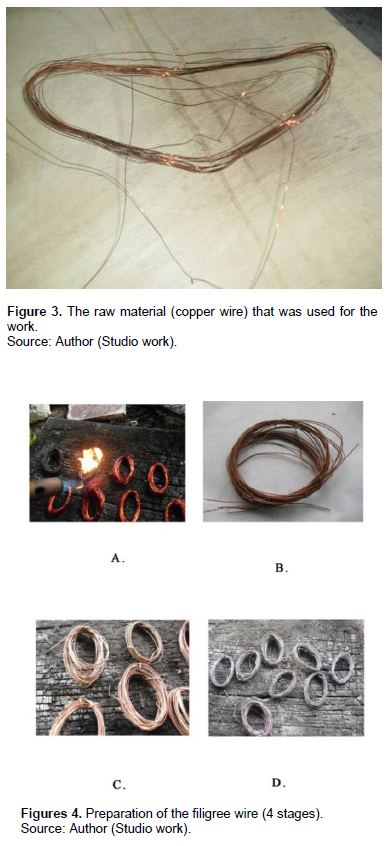
As the activity for the wire twisting continued the twisted portion was drawn away from the top of the table allowing the untwisted portion to be in a better position for it to be twisted. The wire was softened with an intermediate annealing until the entire wires for the filigree bust were twisted.
The wire at this point was prepared for the next stage which was the flattening process. Two options were available for the researcher to use for the flattening of the twisted wire which were hammering and rolling. Due to its ability to ensure even dimensions, the researcher opted for the roll milling technique. In using the rolling mill to flatten the twisted wire the researcher calibrated the platens of the rolling mill to ensure the favourite thickness.
Description of style and the process (stages used in fabricating of the filigree bust)
The purpose of the study was to culminate the creation of a life-sized photorealistic bust which is photorealistic using ancient jewellery making technique of filigree. The fabrication processes were made in six stages. That is, constructing the frames, fitting the frames with twisted (filigree) wires, soldering, piercing, embossing, assembling of parts and finishing. In order to maintain the audience's interest and direct the viewer's eye through the work (filigree bust), many elements of design were employed.
Stage One: Construction of frames and Fitting of the twisted wire into frames
The process of fabricating the filigree bust started with the construction of large frames (Figure 5) with a 2mm square copper wires and subsequently sub- dividing it into smaller units. The frames were annealed for them to be malleable after which they were filled with the twisted wire to fit tightly. The twisted wire made of 25g wire was used for the facial frame, while the rest of the body was constructed with 23g wire. There were three major styles used in filling the frame to obtain the filigree sheet. These included the linear (Figure 6) type of the filling which is locally called 9, 9 (nine, nine), the full coil (Figure 7), and that of densely wrapped (Figure 8) type. The filigree wires were filled in the frame with the help of tools such as pliers, tweezers and cutters.

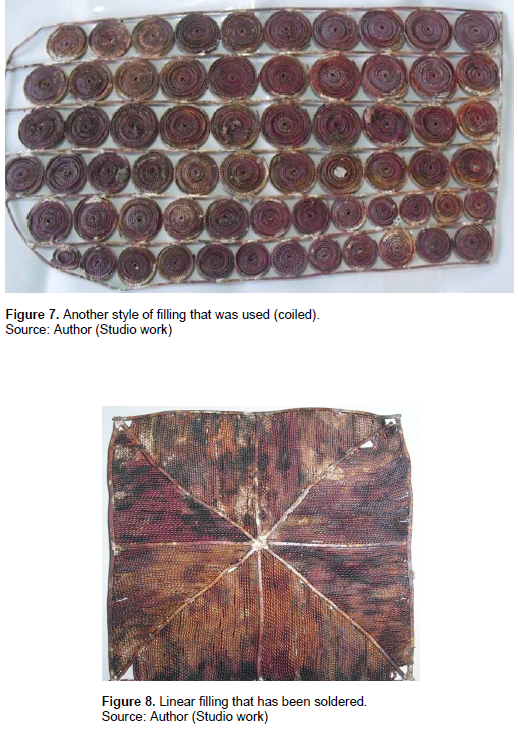
A combination of straight, curved and diagonal filigree wire was used in filling the frames to trap the twisted wire one after the other. To obtain the desired design for the filigree work, the researcher manipulated the twisted wires in the frames to reflect the designs. In particular, it was difficult to fit the first three twisted wires in the frame especially during the filling of the square and rectangular spaces in the frames. This was more prevalent with the 25 gauge wire. What the researchers then did was to solder the first three fitted wires outside the frame before moving them to the frame. This action helps in filling the rest of the filigree wires in the frames at ease. At certain point in the process, the filled filigree wires were soldered after every 5 or 8 rows to pave way for the rest of the filling to be done thereby reducing the difficulties in holding the twisted wires in the frames.
Stage Two: Soldering the fitted frames
Soldering is a process in jewellery making whereby filler metal which is known as solder is melted for the purpose of bonding two or more metal pieces together. Usually, the filler metal has a lower melting point compared to the melting temperature of the base metal. As it has been indicated, the researchers used an open-work filigree type of filigree. This made the wire-to-wire work without any support posing a peculiar soldering challenge. To overcome this, a high refractory and heat-retention charcoal block was used as a temporary support of the work (Figure 8). This facilitated the soldering of the frame with the fitted filigree wire.
Stage three: Piercing
After soldering all the frames with filigree wire fitted in them, the researchers obtained what they termed as Filigree Metal Plates (sheets). The filigree sheets were then pierced based on the segmentation (Figure 9) the researchers had done on the cement model of the person, whose photorealist was produced, using the ancient jewellery making technique of filigree. Piercing here refers to the process of using a jeweller’s saw frame fitted with a fine blade to remove unwanted material from a sheet of metal for the purposes of obtaining intricate shape or motifs.
Stage four: Embossing
The next activity that the researcher undertook during the production of the photorealistic filigree bust after piercing them into segments was embossing. Embossing may be defined as the formation of an impression of motif, decoration, lettering or pattern on another surface on a flat surface such as paper, cloth, metal or even leather, to produce a relief piece of work. When one is undertaking an embossing, s/he presses to push up the surface of the material, which adds a new dimension to the material by volume. Metalsmithes and jewellers make use of embossing to produce raised or sunken designs or relief on sheet metal.
In applying the embossing technique on the work, the pierced filigree metal sheets were pressed to push up (Figures 10 and 11) their surfaces to add a new dimension by way of volume. To achieve this, the pierced segments of the filigree sheet were placed one after the other on their corresponding portion of the model followed by hitting them with a rubber mallet to assume the shape and form of that particular portion of the model. A repetition of this process was carried out until all the components of the bust were completed.
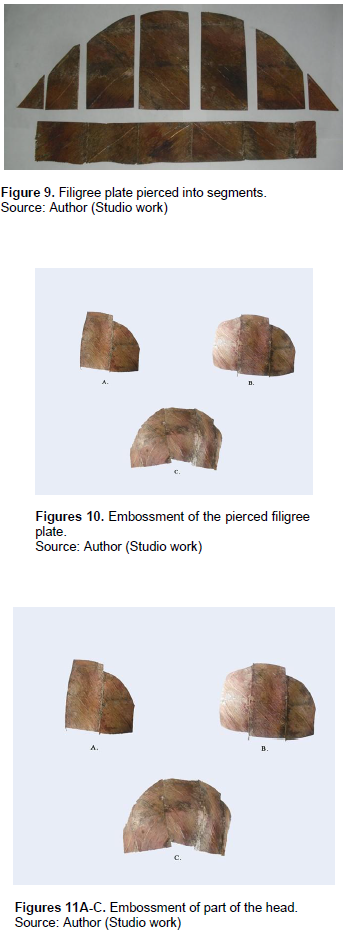
Stage five: Soldering the components of the Filigree bust
Soldering can be defined as the process of placing two or more surfaces in close contact to ensure field continuity across the resulting interface. In other words, soldering is the process of bringing two or more metal pieces, tubes, pipe, or metal sheet into intimate contact in order to establish the continuity of a field across the resulting interface. It must be noted that the metal surfaces to be soldered need be prepared so that the mating of the various parts will be perfectly done. As it has already been alluded to by the researchers, the fabrication of the filigree bust was constructed in parts (Figures 12 to 17) before assembling them together. The work has three major components (head, Neck and the costume) with each having a number of units that constitute these major components of the filigree bust. For example, the parts that make up the head are the face under which forehead, eyes, nose, lips, cheeks, ears, chin and eyes were made and that of the hair. There were also jumper and the cloth that composed the dress of the filigree bust.
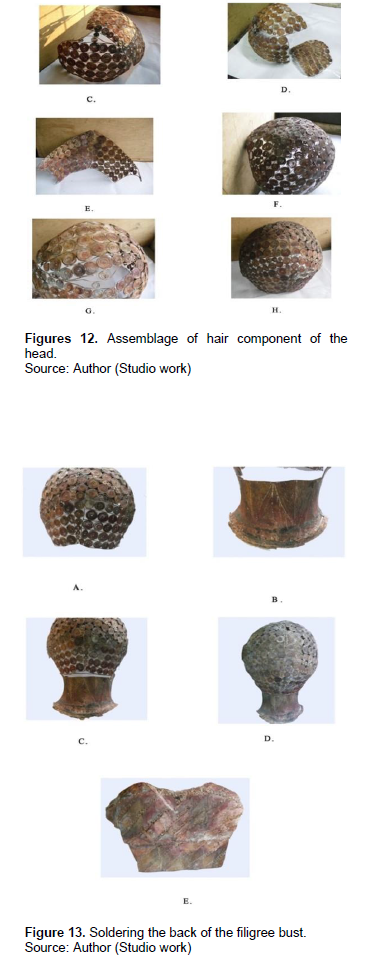
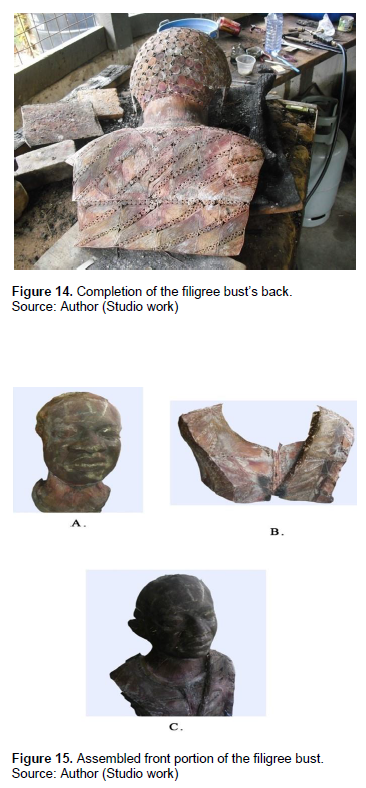
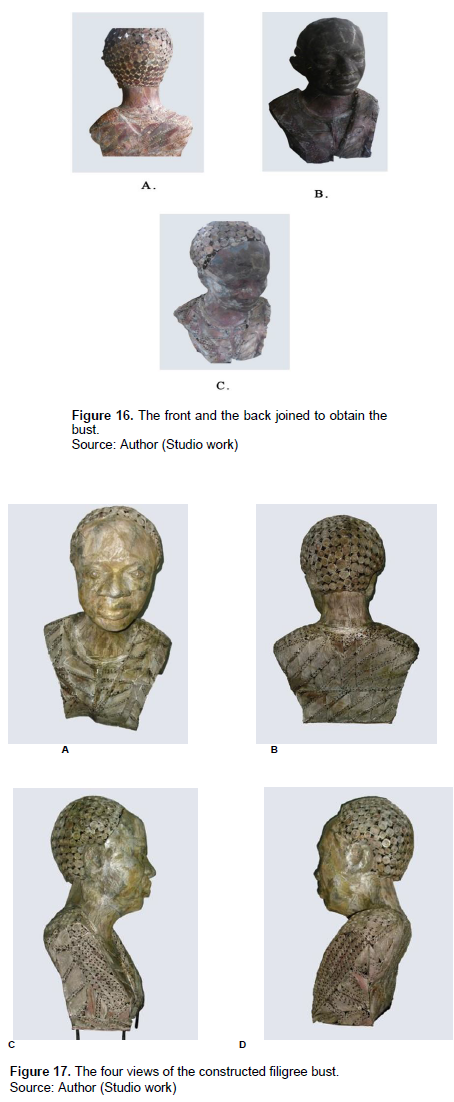
The embossed sections from the pierced filigree plates were joined sequentially in a well-ordered manner to build the life size photorealistic filigree bust of the first president of the Republic of Ghana in the person of Osagyefo Kwame Nkrumah.
Stage six: Finishing the filigree bust
Finishing refers to the removal of scratches and marks on the surface as well as the nature of the final finish, such as satin, matte or polished. The type of finish given to metalwork can transform it, so it was important to plan the finishing of the filigree bust before and during the fabrication stages.
Various finishing techniques such as, polishing, patination and electroplating (gold, silver, nickel, and copper) were considered. The researcher used silver electroplating on account of its availability and used powdered silver solder for soldering major parts of the work which caused some parts of the bust to be coated with silver.
RESULTS AND DISCUSSION
This study aims to determine whether the confinement of filigree technique to jewellery-scaled design and sizes could be breached regardless of the design or size, through the application of filigree technique in jewellery making to design and produce a life size photorealistic bust of Osagyefo Kwame Nkrumah, the first president of Ghana.
The outcome of this study indicated that it is possible to create any sculptural object using a filigree technique, regardless of design and type, through the use of the required material and workshop processes, as shown in the final work piece in Figure 18. The finding echoes what Artstudio64 (2019:2) said: “different small parts are created, then soldered together to build up a wearable sculpture”.
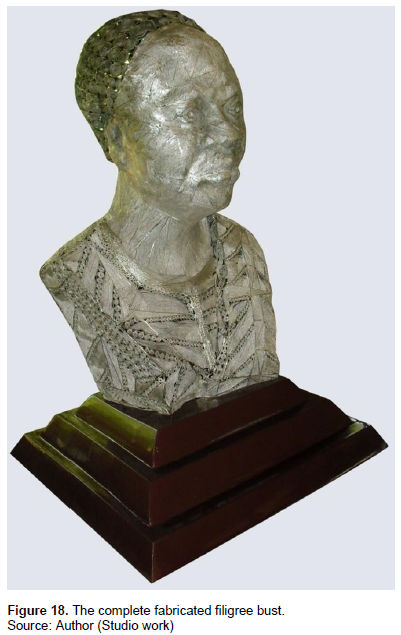
The literature records a close correlation between filigree development and Greek and Etruscan cultures. Both cultures played a pioneering role in creating wire works in the past with them being said to be the first people to manufacture filigree jewellery. Furthermore, the literature review found no apparent correlation between filigree and the sculpture of bust. Unlike the researchers’ fears, this study found no substantial difference between the methods of producing jewellery-scaled articles using the filigree technique and that of the photorealistic filigree bust. The findings of this study confirm the outcome of similar works in the field of artist/historian Briceño (2011), who created kangaroo filigree in titanium metal and laser soldering among other works. However, this study did not find any related evidence in the literature concerning the use of filigree techniques for producing photorealistic sculpture works.
Producing a photorealistic filigree bust was a wonderful experience: a process that pushed the researchers through different emotions, from uncertainty and desperation to enthusiasm, excitement and a successful victory. This reflects the experience shared by Artstudio64 who stated that “I push the fabrication process to its limits in experimentation with line and form, be they straight and austere or curved and intricate” (2). The proponents of the study as practicing jewellers are not used to effectively creating photorealistic items or objects using established skills but they have been able to design and fabricate one of such objects.
It must be highlighted here that it is considered that such an endeavour is impossible in the field of jewellery making. Findings of the study have however proven to be otherwise. This assumption or understanding comes from a lack of desire to explore all the opportunities provided by jewellery and metalsmithing working techniques.
The results of the research showed the integration of elements and principles of design by ensuring that the different parts were not infringed on the overall filigree bust. These include the following:
1. Lines: There are three dimensions of the visual direction through which the eyes travel as one contemplates the filigree bust.
2. Shape: Seamlessly mixes each section to give the shape to the bust.
3. Texture: The twisted wire used in the work gives the quality of the surface to tactile illusions.
4. Room: The bust occupies a positive space despite the open design of the filigree and is bound up by negative space (air).
5. Balance: the distribution of the visual weight of the sections, colour, texture, and space has been effectively applied to achieve a harmonious piece. Both symmetrical and asymmetrical balances were applied. In some instances, it could be observed that the elements used on one side of the design were similar to those on the other sides; whiles in other instance the sides are different but still look balanced. Radial balance was also achieved such that elements were arranged around a central point as it is obvious in the fabrication of the sections forming the hair.
6. Emphasis of focal point is the part of the filigree bust that is aimed at catching the viewer’s attention. The researchers made the face the focal point by contrasting it with other areas through the intentional dense packing of filigree wires in the segments that formed the face.
7. The direction through the filigree bush leads the viewer's eye frequently to focus areas. Such motion is guided in the work along lines, edges, form and colour. The contrasts in the twisted wires' direction trigger movement.
8. Clear patterns on the bust surface have been formed by the filigree cables.
9. The repeated patterns trigger the filigree bust, and even crates in the artwork.
10. The proportion refers to the size of the skull relative to the rest of the body and the components of the face such as the eyes, mouth, nose and ears in the Kwame Nkrumah filigree bust.
11. Rhythm was created by repeatedly using more design elements to create an orchestrated movement feeling. Rhythm is fun and effective in order to keep the viewer's eyes going across the filigree bust.
12. Unity is the feeling of peace that provides a sense of completeness between all parts of the artwork. The nature of this bust exude Bust nature exudes completeness and concept of harmony.
CONCLUSION
Filigree making is the process of curling, twisting and fine folding threads of precious metal wire and fastening them to a specific design by soldering. This implies that the complicated nature of filigree technique restricts the kind of design and scale of metal works that can be manufactured in filigree, which are mainly jewellery and jewellery-scaled items. Against this background, the study aimed to overcome these limitations and expand the spectrum of artefacts that can be produced with filigree technique for the continuation of tradition and formal interpretation of the existing cultural patterns. Upon completion of the study, the researchers drew the conclusion that there is no explanation why filigree technology was limited to mainly ornaments and jewellery-scaled items. The successful results of the research show that filigree technique, regardless of design and measurements, can be used to create any sculpture piece such as bust and photorealistic items.
The study will open avenue for jewellers and sculptors to expand the spectrum of the metal artefacts that they produce thereby increasing their incomes. It is hereby recommended that further studies should be carried out to ascertain if the filigree technique can be combined with other techniques such as granulation, welding, casting and chasing and Repoussé techniques for the creation of metal artefacts other than jewellerry and its related items.
CONFLICT OF INTERESTS
The authors have not declared any conflict of interests.
REFERENCES
|
Artstudio64 (2019). Filigree Jewelry Titanium Jewelry Sculptures. Available at: |
|
|
Briceño XN (2011). Filigree: A Migrant Metal Practice, PhD Thesis, Australia National University Australia. |
|
|
Castellani A (1861). A Memoir on the Jewellery of the Ancients. Jackson and Keeson, Printers. |
|
|
Cosby C (2010). What is Filigree? Available at: |
|
|
Cultural India (n.d.). All About Filigree Jewelry - An Ancient Indian Art. Available at: |
|
|
Design Limited Edition (n.d.). The Ancient Art of Filigree in the World of Luxury Design. Available at: View |
|
|
Estate Diamond Jewelry (2014). What is Filigree? Available at: |
|
|
French C (2017). Patterns around the World: Japanese, Maori, Islamic, Aztec/Mayan, African, Curricula 25. Available at: |
|
|
Marshall C (2010). A Research Design for Studio-Based. A Central Connecticut State University. |
|
|
Rashmi RD (2012). Silver Filigree Jewellery. Available at: |
|
|
Ren K, Min WJ, Xie Y (2020). A Preliminary Study on the Creation of Contemporary Filigree Craft. Art and Design Review 8(4):228-236. |
|
|
Stamati V, Antonopoulos G, Azariadis P, Fudos I (2011). A parametric feature-based approach to reconstructing traditional filigree jewelry. Computer-Aided Design 43(12):1814-1828. |
|
|
Steffano (2013). MAZAL Precious indulgence/what is filigree. Available at: |
|
|
Sullivan G (2006). Research Acts in Art Practice, A journal of Issues and Research 48(1):19-35. |
|
|
The Drum (2007). George Cox. Available at: |
|
|
The Palace Museum (2016). Classics of the Forbidden City (P 208). Beijing: The Forbidden City Publishing House |
|
|
Yan JC, Zhang MF, Sun SY (2016). The origin and definition of the concept of filigree inlay. Journal of Guangxi University for Nationalities 22:30-38. |
|
|
Wikipedia (n.d.). Tara Brooch. Available at: |
|
Copyright © 2024 Author(s) retain the copyright of this article.
This article is published under the terms of the Creative Commons Attribution License 4.0